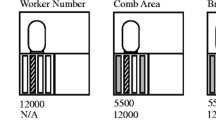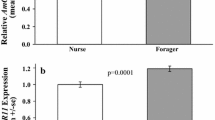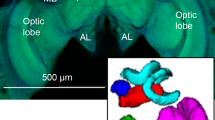Abstract
Honey bee colonies can respond to changing environmental conditions by showing plasticity in age related division of labor, and these responses are associated with changes in juvenile hormone. The shift from nest taks to foraging has been especially well characterized; foraging is associated with high juvenile hormone titers and high rates of juvenile hormone biosynthesis, and can be induced prematurely in young bees by juvenile hormone treatment or by a shortage of foragers. However, very few studies have been conducted that study plasticity in division of labor under naturally occurring changes in the environment. To gain further insight into how the environment and juvenile hormone influence foraging behavior, we measured juvenile hormone titers and rates of biosynthesis in workers during times of the year when colony activity in temperate climates is reduced: late fall, winter, and early spring. Juvenile hormone titers and rates of biosynthesis decreased in foragers in the fall as foraging diminished and bees became less active. This demonstration of a natural drop in juvenile hormone confirms and extends previous findings when bees were experimentally induced to revert from foraging to within-hive tasks. In addition, endocrine changes in foragers in the fall are part of a larger seasonally related phenomenon in which juvenile hormone levels in younger, pre-foraging bees also decline in the fall and then increase the following spring as colony activity increases. The seasonal decline in juvenile hormone in foragers was mimicked in summer by placing a honey bee colony in a cold room for 8 days. This suggests that seasonal changes in juvenile hormone are not related to photoperiod changes, but rather to changes in temperature and/or colony social structure that in turn influence endocrine and behavioral development. We also found that active foragers in the late winter and early spring had lower juvenile hormone levels than active foragers in late spring. In light of recent findings of a possible link between juvenile hormone and neuroanatomical plasticity in the bee brain, these results suggest that bees can forage with low juvenile hormone, after previous exposure to some threshold level of juvenile hormone leads to changes in brain structure.
Similar content being viewed by others
Abbreviations
- CA:
-
corpora allata
- dpm:
-
decays per minute
- HPLC:
-
high performance liquid chromatography
- JH:
-
Juvenile hormone
- RIA:
-
radioimmunoassay
References
Arnold AP, Gorski RA (1984) Gonadal steroid induction of structural sex differences in the CNS. Annu Rev Neurosci 7:413–442
Banin D, Haim A, Arad Z (1994) Metabolism and thermoregulation in the levant vole Microtus guentheri—the role of photoperiodicity. J Therm Biol 19:55–62
Breedlove SM (1992) Sexual differentiation of the brain and behavior. In: Becker JB et al (eds) Behavioral endocrinology. MIT Press, Cambridge, Mass., pp 39–70
Burgett M, Burikam I (1985) Number of adult honey bees (Hymenoptera: Apidae) occupying a comb: a standard for estimating colony populations. J Econ Entomol 78:1154–1156
Bühler A, Lanzrein B, Wille H (1983) Influence of temperature and carbon dioxide concentration on juvenile hormone titre and dependent parameters of adult worker honey bees (Apis mellifera L.). J Insect Physiol 29:885–893
Cherednikov AV (1967) Photoperiodism in the honey bee, Apis mellifera. Entomol Rev 46:33–37
Davis RL (1993) Mushroom bodies and Drosophila learning. Neuron 11:1–14
Debelle JS, Heisenberg M (1994) Associate odor learning in Drosophila abolished by chemical ablation of mushroom bodies. Science 263:692–695
De Kort CA (1990) Thirty-five years of diapause research with the Colorado potato beetle. Entomol Exp Appl 56:1–13
De Kort CA, Granger NA (1981) Regulation of the juvenile hormone titer. Annu Rev Entomol 26:1–28
De Kort CAD, Koopmanschap AB, Strambi C, Strambi A (1985) The application and evaluation of a radioimmunoassay for measuring invenile hormone titres in Colorado beetle haemolymph. Insect Biochem 15:771–775
De Wilde J, Duintjer CA, Mook L (1959) Physiology of diapause in the adult Colorado beetle (Leptinotarsa decemlineata). I. The photoperiod as a controlling factor. J Insect Physiol 3:75–85
Eizaguirre M, Lopez C, Asin L, Albajes R (1994) Thermoperiodism, photoperiodism and sensitive stage in the diapause induction of Sesamia nonagrioides (Lepidoptera, Noctuidae). J Insect Physiol 40:113–119
Erber J, Homberg U, Gronenberg W (1987) Functional roles of the mushroom bodies in insects. In: Gupta AP (ed) Arthropod brain: its evolution, development, structure and functions. Wiley, New York, pp 484–512
Fluri P, Boganov S (1987) Effects of artificial shortening of the photoperiod on honey bee (Apis mellifera) polyethism. J Apic Res 26:83–89
Fluri P, Lüscher M, Wille H, Gerig L (1982) Changes in weight of the pharyngeal gland and haemolymph titres of juvenile hormone, protein and vitellogenin in worker honey bees. J Insect Physiol 28:61–68
Fluri P, Wille H, Gerig L, Lüscher M (1977) Juvenile hormone, vitellogenin and haemocyte composition in winter worker honeybees (Apis mellifera). Experientia 33:1240–1241
Frisch K von (1967) The dance language and orientation of bees. Belknap/Harvard Univ Press, Cambridge, Mass.
Goodman WG, Coy DC, Baker FC, Xu L, Toong YC (1990) Development and application of a radioimmunoassay for the juvenile hormones. Insect Biochem 20:357–364
Hagenguth H, Rembold H (1978) Identification of juvenile hormone 3 as the only juvenile hormone homolog in all developmental stages of the honey bee. Z Naturforsch 33C:847–850
Heisenberg M, Borst A, Wagner S, Byers D (1985) Drosophila mushroom body mutants are deficient in olfactory learning. J Neurogenet 2:1–30
Henley J, Greenwood J, Stout J, Atkins G (1992) Age-correlated changes and juvenile hormone III regulation of the syllable period specific responses of the L3 auditory interneurons in the cricket, Acheta domesticus. J Comp Physiol A 170:373–378
Huang Z-Y, Robinson GE (1992) Honeybee colony integration: worker-worker interactions mediate hormonally regulated plasticity in division of labor. Proc Natl Acad Sci USA 89: 11726–11729
Huang Z-Y, Robinson GE, Borst DW (1994) Physiological correlates of division of labor among similarly aged honey bees. J Comp Physiol A 174:731–739
Huang Z-Y, robinson GE, Tobe SS, Yagi KJ, Strambi C, Strambi A, Stay B (1991) Hormonal regulation of behavioural development in the honey bee is based on changes in the rate of juvenile hormone biosynthesis. J Insect Physiol 37:733–741
Hunnicutt, D, Toong YC, Borst DW (1989) A chiral specific antiserum for juvenile hormone. Am Zool 29: 48a
Jaycox ER (1976) Behavioral changes in worker honey bees (Apis mellifera L.) after injection with synthetic juvenile hormone (Hymenoptera: Apidae). J Kans Entomol Soc 49:165–170
Jaycox ER, Skowronek W, Gwynn G (1974) Behavioral changes in worker honey bees (Apis mellifera) induced by injections of a juvenile hormone mimic. Ann Entomol Soc Am 67: 529–534
Kaatz H-H, Hagedorn HH, Engels W (1985) Culture of honeybee organs: development of a new medium and the importance of tracheation. In Vitro Cell Dev Biol 21:347–352
Karp JD, Powers JB (1993) Photoperiodic and pineal influences on estrogen-stimulated behaviours in female Syrian hamsters. Physiol Behav 54:19–28
Kelly DB (1986) The genesis of male and female brains. Trends Neurosci 9:499–502
McEwen BS, Coirini H, Westlin D, Danielsson A, Frankfurt M, Gould E, Schumacher M, Wooley C (1991) Steroid hormones as mediators of neural plasticity. J. Steroid Biochem Molec Biol 39: 223–232
Merz R, Gerig L, Wille H, Leuthold R (1979) Das Problem der Kurz- und Langlebigkeit bei der Ein- und Auswinterung im Bienenvolk (Apis mellifera): Eine Verhaltensstudie. Rev Suisse Zool 86:663–671
Milojévic BD (1940) A new interpretation of the social life of the honeybee. Bee World 21:39–41
Moritz RFA, Southwick EE (1992) Bees as superorganisms, an evolutionary reality. Springer, Berlin Heidelberg
Neukirch A (1982) Dependence of the life span of the honeybee (Apis mellifera) upon flight performance and energy consumption. J Comp Physiol A 146:35–40
Page RE, Robinson GE (1991) The genetics of division of labour in honey bee colonies. Adv Insect Physiol 23:117–171
Page RE, Robinson GE, Britton DS, Fondrk MK (1992) Genotypic variability for rates of behavioral development in worker honey bees (Apis mellifera). Behav Ecol 3:173–180
Palli SR, Touhara K, Charles J-P, Bonning BC, Atkinson JK, Trowell SC, Hiruma K, Goodman WG, Kyriakides T, Prestwich GD, Hammock BD, Riddiford LM (1994) A nuclear juvenile hormone binding protein from larvae of Manduca sexta: aputative receptor for the metamorphic action of JH. Proc Natl Acad Sci USA 91:6191–6195
Pellet FC (1938) History of American beekeeping. Collegiate Press, Ames, Iowa
Pener MP (1992) Environmental cues, endocrine factors, and reproductive diapause in male insects. Chronobiol Internat 9:102–113
Phillips EF (1915) Beekeeping. MacMillan, New York
Pratt GE, Tobe SS (1974) Juvenile hormones radiobiosynthesized by corpora allata of adult female locusts in vitro. Life Sci 14: 575–586
Rafaeli A, Soroker V, Hirsch J, Kamensky B, Raina AK (1993) Influence of photoperiod and age on the competence of pheromone glands and on the distribution of immunoreactive PBAN in Helicoverpa spp. Arch Insect Biochem Physiol 22: 169–180
Robinson GE (1985) Effects of a juvenile hormone analogue on honey bee foraging behaviour and alarm pheromone production. J Insect Physiol 31:277–282
Robinson GE (1987a) Regulation of honey bee age polyethism by juvenile hormone. Behav Ecol Sociobiol 20:329–338
Robinson GE (1987b) Modulation of alarm pheromone perception in the honey bee: evidence for division of labor based on hormonally regulated response thresholds. J Comp Physiol A 160: 613–619
Robinson GE (1992) Regulation of division of labor in insect societies. Annu Rev Entomol 37:637–665
Robinson GE, Ratnieks F (1987) Induction of premature honey bee (Hymenoptera: Apidae) flight by juvenile hormone analogs administered orally or topically. J Econ Entomol 80:784–787
Robinson GE, Strambi A, Strambi C, Paulino-Simões ZL, Tozeto SO, Barbosa JMN (1987) Juvenile hormone titers in Africanized and European honey bees in Brazil. Gen Comp Endocrinol 66: 457–459
Robinson GE, Page RE, Strambi C, Strambi A (1989) Hormonal and genetic control of behavioral integration in honey bee colonies. Science 246:109–112
Robinson GE, Strambi C, Strambi A, Feldlaufer MF (1991) Comparison of juvenile hormone and ecdysteroid haemolymph titers in adult worker and queen honey bees (Apis mellifera). J Insect Physiol 37:929–935
Robinson GE, Page RE, Strambi C, Strambi A (1992) Colony integration in honey bees: mechanisms of behavioural reversion. Ethology 90:336–350
Rösch GA (1930) Untersuchungen über die Arbeitsteilung im Bienenstaat. II. Die Tätigkeiten der Arbeitsbienen unter experimentell veränderten Bedinguangen. Z Vergl Physiol 12:1–71
Sasagawa H, Sasaki M, Okada I (1986) Experimental induction of the division of labor in worker Apis mellifera L. by juvenile hormone and its analog. 30th Int Congr Apicult, Apimondia. Nagoya, pp 130–132
Seeley TD, Visscher PK (1985) Survival of honeybees in cold climates: the critical timing of colony growth and reproduction. Ecol Entomol 10:81–88
Steel RGD, Torrie JH (1980) Principles and procedures of statistics, a biomedical approach. McGraw-Hill, New York
Stout J, Atkins G, Zacharias D (1991) Regulation of cricket phonotaxis through hormonal control of the threshold of an identified auditory neuron. J Comp Physiol A 169:765–772
Stout J, Hayes V, Zacharias D, Henley J, Stumpner A, Hao J, Atkins G (1992) Juvenile hormone controls phonotactic reponsiveness of female crickets by genetic regulation of the response properties of identified auditory interneurons. In: Mauchamp B et al. (eds) Insect iuvenile hormone research: fundamental and applied approaches. Institute National Recherche Agronomique, Paris, pp 265–283
Strambi C, Strambi A, Reggi M de, Hirn M, Delaage M (1981) Radioimmunoassay of insect juvenile hormone and of their diol derivatives. Eur J Biochem 118:401–406
Tanaka S, Hakomori T, Hasegawa E (1993) Effects of daylength and hopper density on reproductive traits in a Japanese population of the migratory locust, Locusta migratoria L. J Insect Physiol 39: 571–580
Tobe SS, Pratt GE (1974) The influence of substrate concentrations on the rate of insect juvenile hormone biosynthesis by corpora allata of the desert locust in vitro. Biochem J 144:107–133
Winston ML (1987) The biology of the honey bee. Harvard Univ. Press, Cambridge, Mass.
Withers GS, Fahrbach SE, Robinson GE (1993) Selective neuroanatomical plasticity and division of labour in the honeybee. Nature 364:238–240
Withers GS, Fahrbach SE, Robinson GE (1995) Effects of experience and juvenile hormone on the organization of the mushroom bodies of honey bees. J Neurobiol 26:130–144
Author information
Authors and Affiliations
Additional information
Communicated by L.C.-H. Wang
Rights and permissions
About this article
Cite this article
Huang, Z.Y., Robinson, G.E. Seasonal changes in juvenile hormone titers and rates of biosynthesis in honey bees. J Comp Physiol B 165, 18–28 (1995). https://doi.org/10.1007/BF00264682
Accepted:
Issue Date:
DOI: https://doi.org/10.1007/BF00264682




